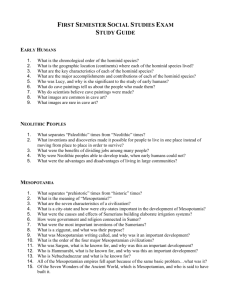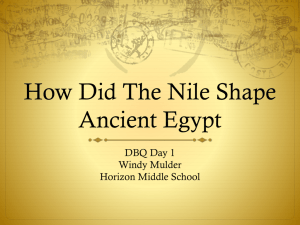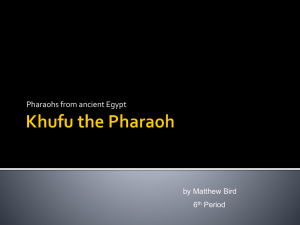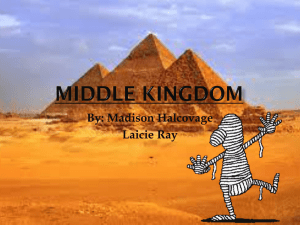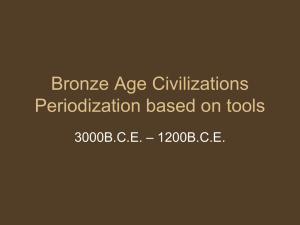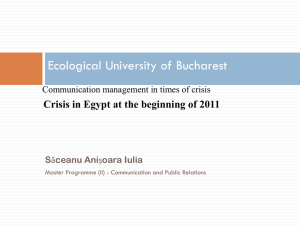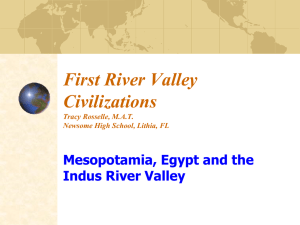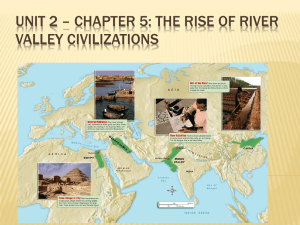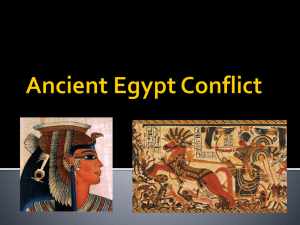Chapter 1 Origins - SJS AP World History
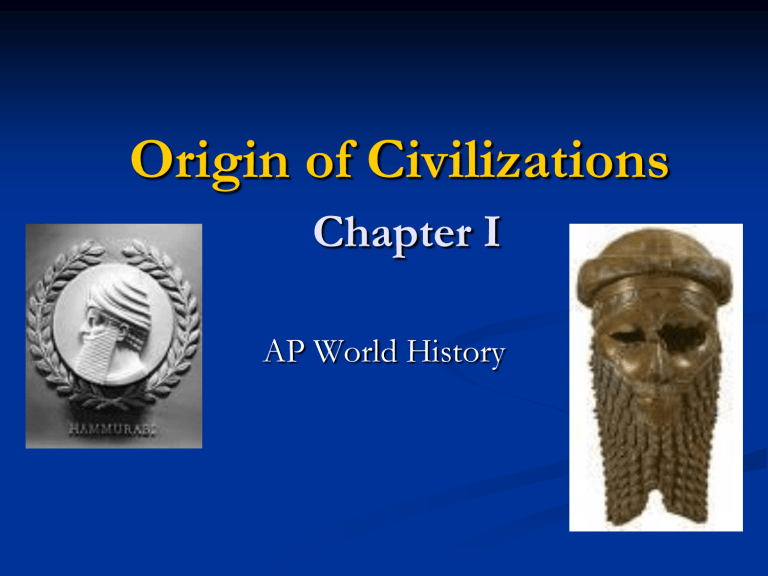
Origin of Civilizations
Chapter I
AP World History
Timeline
The Spread of Human Populations, c.
10,000 B.C.E.
The Spread of Agriculture
Big Picture “Snap Shot”
Most people were still nomadic hunter and gatherers, in spite of the new civilizations- only about 5% lived in cities.
Definitions of civilization: Elements: urban, monumental building, writing, specialized occupations Aspects of civilizations? Cities, writing,
& political organization
Animismbelief that things in nature have souls or conscience, later a supernatural force animates & organizes the universe.
Key Events
(Neolithic) Agriculture Revolutions (Actually more like an evolution)
Earliest known settlements about 7000 BCE
Jericho (Jordan River ) & Catal Huyuk in Turkey
Early river valley civilizations, advanced urban cultures of Mesopotamia
& Egypt
Key technology- irrigation
Cultural hearths develop (meaning where civilizations began)
Origins of major religions
Mesopotamia 3200-1500BC: State
Building , Expansion, & Conflict:
“Political” structures & forms of governance:
Type of system- Sumerian states were not unified until about
2300BCE when Sargon the Great conquered the area
- Before Sargon- most city states were theocracies
Empires- (Nations)
Sargon started the Akkadian Empire (Akkad, near current Baghdad)
About 2200 BCE city-state of Ur took over power – controlling trade
During 1700s BCE- Hammurabi started the 1 st Babylonian Empire
Revolts and revolutions
Global structures - Not many global interactions at the time just trade usually local.
State Building , Expansion, & Conflict:
“Political” structures & forms of governance
Type of system- Monarchy/Theocracy
Pharaohs enjoyed more power & prestige than almost any ruler in World History. (god)
Empires-
Old Kingdom (3100-2500BCE) Most powerful little outside influence. Start of
Pyramids as Tombs (Djoser’s Pyramid and his architect Imhotep)
Middle Kingdom (2100-1650BCE) Peaceful period until the Hyksos invaded/assimilated, start of Bronze Age in Egypt, started trade with neighbors, middle class of merchants & officials,
Egypt, Kush and Axum
State Building , Expansion, & Conflict:
New Kingdom (1570-700BCE) Most recognized time & names of
Pharaohs, started conquering nations Nubia 1st, Hebrew Exodus, Battle of Kadesh against the Hittites. Downfall after 1200BCE,
Then Egyptian Empire was gone, back to the Nile River enduring:
Invasion by “Sea Peoples” 1200BCE,
Libya 950BCE and later Nubian reunification/Assimilation
Phoenician “Purple People” influence Culture (Carthage 813BCE)
Kush invaded 777-750BCE, Pianky became rulerAssimilated
671 BC the Assyrian Empire invaded Egypt
End of Ancient Egypt:
605 BCE Babylonian king Nebuchadnezzar invaded
526 BCE Persians invaded and assume power
404 Egypt regains independence
338 Persia regains control
Alexander the Great Egypt 332 BCE Ptolemy Dynasty 323BCE
Romans after times of protection etc… Octavian invades 30BCE
Kush & Nubia
Creation, Expansion, and
Interaction of “Economic” systems
The Neolithic Revolution - 8000 to 3500 B.C.E.
Agricultural & pastoral production;
Horticulture (seed planting, science of plant cultivation)
Development of the “Fertile Crescent”
Animals began to be domesticated, Animals from 12,000 B.C.E.: dogs, sheep, goats, pigs
Sedentary agriculture (Year round farming) used to plow fields (slow development – Revolution?)
Most believe it was caused by climatic shifts
Began the development of towns
The Spread of the Neolithic Revolution
Hunting-and-gathering persists
Pastoralism is animal husbandry
Some mobile = Nomadic tribes
Search of fresh pasture and water
Crops & Material:
Sub-Saharan Africa = root and tree crops
Northern China = millet
Southeast Asia, to China, India, islands = Rice
Mesoamerica, Peru = Maize, manioc, sweet potatoes
5,000 years later….
Bronze Age : Copper + Tin = Bronze {Brass}
Creation, Expansion, and
Interaction of “Economic” systems
Trade & Commerce3000-1700BCE Local trade, little contact with Egypt
All the city-states were economically independent, but local battles and war slowly unified them economically.
About the time of Hammurabi 1700s BCE the
Babylonians started trading actively with many countries including Egypt.
Labor system- Slaves made up a big portion of the coordinated projects, unpleasant/dangerous work
Most people would work together on the irrigation
Occupations:
Read and write: Scribes, Bookkeepers, & Priests
The start of craftsman[ artisans ] - (not literate, but trained) metal, leather, pottery, jewelry, carpentry, masonry.
Development & Interaction of Cultures –
“Religions”
Mesopotamia Sacred text-2000BCE, (Oral since about 7000BCE),
Epic of Gilgamesh, Uruk
Pursuit of eternal life, but did not find it.
Egyptian Sacred textThe Book of the Dead – funeral rites, and the after life, copy buried with body in the new Kingdom.
Key beliefs- Polytheistic, deities intervening in human affairs, each city had its own God, they worshiped their Gods because they were mighty,
Mesopotamia Sacred Place/structure – Ziggurats
Amulets were found on remains- evil spirits, Evidence Religious festivals
Egyptian Sacred place – Pyramids (Rock Blocks/slabs)
Was it Universal & Ethnic?? Diffusion/spread, why? (clues?)
Development & Interaction of
Cultures continued…
Science/Technology-Mathematics (Units of 60, 10, 6)
Mesopotamia far more advance in math than Egypt.
Architecture/Buildings- Ziggurats-(bricks)
Art- Cuneiform, Statues, paintings, & Code of
Hammurabi
Development & transformation of social structures “Culture”
Gender Roles and relations
Women’s roles, status – After Neolithic Revolution the distinction between the status of men & women happened
Women lost economic power of “Gathering”
With Agriculture men slowly took over women's roles animals and plants
In Mesopotamia & Egypt both were a patriarchal society.
But in Egypt women were in a higher status i.e..
Goddesses of Creativity & Marriage alliances
Development & transformation of social structures “Culture”
Mesopotamian Society, Elite/Non elites, 4 categories:
1.
2.
3.
4.
Nobles- King, his family, chief priest, & high palace officials
Free Clients of the nobility- Laborers of the Nobility, worked the land, in return rec’d small plots of land. (Similar to later feudal system)
Commoners- Free citizens independent of nobility, but not the social status or political power, they owned land and were protected by laws.
Slaves/Ethnic classes- Slaves were usually captured foreigners/POWs, plus criminals, or paying debts.
Family & kinship (Clans)-Lived in traditional family units.
Heavy penalties for adultery
Husband had absolute power
Development & transformation of social structures “Culture” Cont…
Communication:
Mesopotamian Language- Sumerian
Later Semite, bases of most Arab languages
Egyptian for Egypt
Hittites Indo-European
Mesopotamian Writing system- 3500BCE Cuneiform
Egyptian Writing – Hieroglyphics-
“Interactions” between
Humans and environment
Migrations- Theory outward from Middle East from central Africa…some local trade….
Settlement patterns along river valleys
Technology (impact on environment)-
Redirection of water through irrigation
Bricks for the Ziggurats
Limestone blocks for Pyramids
Both cultures into astrology
Settlements, villages
Slash and burn agriculture
Major Comparisons/Contrasts
Egypt and Mesopotamia
Nile and Euphrates/Tigris Rivers
Bronze Age (cooper & tin) Mesopotamia 3000BCE / Egypt
1700BCE after being attacked by Hyksos
Iron Age happened about 1000BCE (More inter-relation)
Religions: Polytheist
Economy: very similar (stone cutter to Egypt)
Writing: Hieroglyphs (Picture graphs) v. Cuneiform
Buildings: Ziggurats vs. Pyramids
A Major Contrast:
Their geographical location shaped very different political, economic, and cultural beliefs and practices. Egypt was isolated for much of its existence, while Mesopotamia was at a cross roads of population movements, and invasion
Overview of Mesopotamian & Egypt
Continuity & Change-over-Time(C.C.O.T)
Continuities:
Early regional cultural hearths diffusion/movement of material and non material culture
Irrigation based advanced, settled urban cultures
Conflict between settled and nomadic cultures
Slavery generally consequences of conquest, debts, or poverty.
Changes:
C.C.O.T. continued….
Increased % of people living in settled, agricultural, cultures
Increased population in advanced, urban cultures
Decline in status of women, increased patriarchy in agricultural based societies
Increased local and later regional trade routes
Rise and fall of empires
